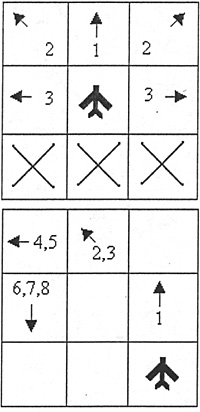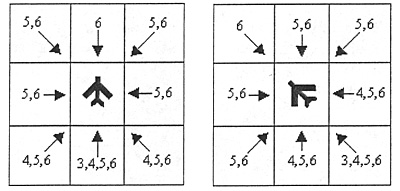I. Purpose
- A. The purpose is to simulate Korean War air battles with a game that is short and simple.
B. The rules are designed to be played solo or by two players.
C. This game simulates a Mig-15 squadron and an F-86 squadron on patrol over North Korea. Each squadron takes turns conducting three sorties. Whenever an enemy plane is encountered on the Sortie Chart, a Mig or a Sabre jet (whichever represents the active side) will engage the type of airplane listed in square.
D. The winner is the side that shoots down the greatest number of the opponent’s airplanes in three rounds (sorties).
II. Equipment
- A. The game will require a Sortie Chart and a Battle Board.
- 1. The Sortie Chart contains a course of 22 squares with seven Communist planes and seven Allied planes listed in random order.
2. The Battle Board is made from a regular 22”x28” sheet of poster board divided into 2” squares. The Battle Board is 11 squares wide and 14 squares long.
B. One small model of a Mig-15, a Yak-9, an F-86; an F-84; an F-80, a Meteor, and an F-51 will be needed.
C. Each side will need 1 six-sided die for movement (red for the Mig and blue for the Sabre).
D. Each side will need 1 marker (a washer painted red for the Communists and blue for the Allies).
III. Procedure
- A. Roll a red and a blue D6 to decide which side will start the game. The side with the high score moves first on the Sortie Chart. Roll 1D6 and move the washer one square for each dot. If the marker lands on an empty square or a square listing a friendly plane, nothing happens; keep rolling and moving the washer. If the marker lands on a square listing an enemy plane, combat will take place between a Mig or a Sabre (depending upon which squadron is active) and the airplane identified in the square.
B. Place each plane on the opposite corners of the short sides of the Battle Board. Each plane should be facing ahead, not diagonally.
C. Roll both colored dice to determine which plane will move first. The high roll moves first. To determine the number of Movement Points (MPs) available for each movement turn, roll 1D6 and add the number rolled to the plane’s Base Value modifier. The sides will take turns rolling and moving the airplanes until combat occurs.
D. Movement on the Battle Board. Maneuvering an aircraft requires Movement Points (MPs). The only moves allowed are straight ahead, a 45o degree diagonal, and a 90o degree wing-over. Straight-ahead movement costs 1 MP per square. Diagonal movement costs 2 MPs per square. A 90 o wing-over costs 3 MPs.
- Only one wing-over is allowed per movement turn!
An aircraft cannot stand still, move sideways, or move backwards in a move. The aircraft will always face the direction in which it moves. An aircraft cannot land in a square from one direction and be turned to face a different direction. (See Figure 1.)
 Figure 1. Airplanes may move straight ahead (1 MP), diagonally (2 MPs), or sideways (3 MPs).
Figure 1. Airplanes may move straight ahead (1 MP), diagonally (2 MPs), or sideways (3 MPs).
Figure 2. An example of an airplane using 8 Movement Points to perform 1 forward, 2 diagonal, and 1 sideways (wing-over) movement.
E. Movement Points for each turn are acquired in the following manner:
- Swept-wing jets: Base Value of 6 + 1D6 = MP
Straight-wing jets: Base Value of 4 + 1D6 = MP
Prop planes Base Value of 2 + 1D6 = MP
F. The object of maneuvering is to attack the enemy airplane. Combat occurs when a target occupies the square directly in front of an airplane. 1D6 is rolled to determine a kill. (See Figure 3.)
- 1. Attacking from the front requires a 6 to hit and destroy.
2. Attacking diagonally from the front or from the side requires a 5 or 6 to hit and destroy.
3. Attacking diagonally from behind requires a 4, 5, or 6 to hit and destroy.
4. Attacking from directly behind the target requires a 3, 4, 5, or 6 to hit and destroy.
G. If an airplane attacks directly from the front and misses, the target may return fire at the beginning of its next turn before it moves. Or, it may choose to hold its fire and maneuver for a better shot.
H. An airplane does not have to use all of its movement points before attacking. For example, if an airplane has ten MPs and can line up on the target using only five, it may attack. The remaining MPs are discarded.
 Figure 3. The numbers needed on 1D6 to destroy a target from different attack positions.
Figure 3. The numbers needed on 1D6 to destroy a target from different attack positions.
I. If the target is destroyed, the kill should be recorded to help determine the eventual winner of the game.
J. The combat encounter ends and the play moves back to the Sortie Chart after (1) one plane is shot down, or (2) both planes have fired once. It is possible for one plane to fire several times before the other plane fires once. The engagement ends immediately after both planes have fired.
K. Moving the marker completely around the Sortie Chart represents a complete squadron sortie. After one side completes a sortie, the other side will move its marker around the Sortie Chart.
L. Each side will have three sorties. A record will be kept of the kills for each side, and the side that scores the most kills in the three sorties will win the game.
M. Play testing notes:
- 1. The plane that moves first on the Battle Board is in danger of being “bounced’ on the next turn if opposed by a jet. Maneuver to stay out of reach and to face the enemy at the end of the first move.
2. Although the odds are against it, the slow prop planes are perfectly capable of bringing down a swept-wing jet. Watch out!
IV. Variations
- A. An alternate way of scoring is to award each side the Base Value of the planes it destroys. For example, if an F-86 shot down a Yak-9 and a Mig-15, the Allies would receive 2 points for the Yak and 6 points for the Mig. The side with the most points at the end of three sorties wins the game.
B. This game also may be played as a campaign by extending the number of sorties. You can roll 2 or 3 dice or set a number arbitrarily. For example, each sortie could represent a day and seven sorties would produce a campaign of one week, etc.
C. A role-playing element can be added to a campaign by listing the names of six pilots in each squadron. Assign each pilot a number from one to six. Whenever a combat occurs, roll 1D6 to identify the active squadron’s pilot before the planes start to move. If a pilot is killed during combat, replace his name on the chart with the name of a new pilot. Eventually, some of the pilots may score five kills and become aces. Add 1 point to an ace’s movement and combat rolls for the remainder of the campaign.
MiGs and Sabres
Related
MiG Pilot Korean War Solo Game
Back to Table of Contents -- Lone Warrior # 146
Back to Lone Warrior List of Issues
Back to MagWeb Magazine List
© Copyright 2004 by Solo Wargamers Association.
This article appears in MagWeb.com (Magazine Web) on the Internet World Wide Web.
Other articles from military history and related magazines are available at http://www.magweb.com
